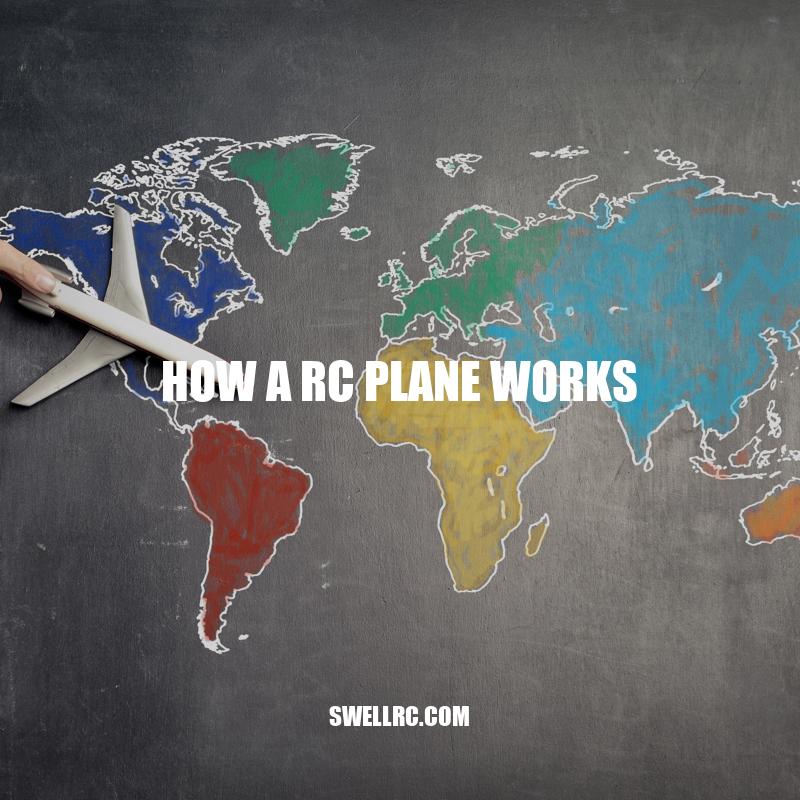How RC Planes Work: Understanding the Basics
Radio-controlled (RC) planes have been a popular pastime for many years, with enthusiasts of all ages taking to the skies with their scale model planes. These miniature planes provide both a thrilling and educational experience for enthusiasts who are interested in aviation, engineering, and design. Typically, an RC plane consists of a lightweight frame or fuselage, wings, a motor, and a radio system. The plane’s movement is controlled remotely through the radio system, which sends signals to the plane’s inbuilt receiver that activates the various control surfaces. In this article, we will delve into how an RC plane works, examine the critical components and their roles, and explain the aerodynamic principles that keep the plane soaring through the air. Whether you’re a seasoned pilot or a beginner looking to get into the thrilling hobby of RC planes, this article has something for everyone.
Components of an RC Plane
To understand how an RC plane works, it’s essential to understand the components that make up its design. These components include:
- Fuselage: The body of the plane, which houses the engine, battery, and all other electronic components.
- Wings: The primary lifting surfaces of the plane, which generate lift and enable the plane to fly.
- Motor: The engine that provides power to the propeller, which generates forward thrust.
- Control Surfaces: The movable parts of the plane, such as the rudder, elevator, and ailerons, which the pilot employs to control the plane’s movements.
- Radio System: The system that sends control signals from the pilot to the control surfaces, allowing the pilot to direct the plane’s movements.
These components work together to keep the plane in the air and allow the pilot to control its movements. Beginners can purchase ready-to-fly (RTF) models, which are preassembled and require minimal setup. Hobbyists can also purchase build-it-yourself kitsto construct customized planes from scratch to their preferences. Various websites and shops offer a range of RC planes for all skill levels, where you can get started on this fantastic hobby.
How does a RC plane work?
Here are the basics of how a Radio-Controlled (RC) plane works:
- The remote control sends signals to a receiver in the plane.
- The receiver translates these signals into electric commands that control the various parts of the plane, such as the motor, wings, and tail.
- Electricity provided by a battery powers the motor, which propels the plane forward.
- The wings create lift, allowing the plane to take off and stay in the air.
- The tail controls the direction and stability of the plane.
For more detailed information on RC planes and other RC products, visit websites such as Horizon Hobby, Tower Hobbies, or RC Groups.
How a RC Plane Takes Off
Taking off an RC plane requires a comprehensive understanding of the aerodynamics involved. The process is as follows:
| Step | Description |
|---|---|
| Power Up | The pilot powers up the RC plane to start the motor and propeller. |
| Taxiing | The pilot maneuvers the RC plane on the ground using the rudder control until it reaches the takeoff runway. |
| Takeoff Roll | The pilot applies throttle to the motor to achieve enough airspeed to generate lift. |
| Lift Off | The wings start producing enough lift as the RC plane gains airspeed and gravity reduces its weight on the wheels. |
Some interesting facts about RC plane takeoff include:
- Models designed for takeoff from water sources like rivers and lakes are available.
- Some advanced RC planes use retractable landing gear that folds away during flight, reducing drag and improving aerodynamic performance.
Various websites offer a comprehensive overview of how to take off an RC plane. Additionally, people can purchase RC planes online or from local hobby shops.
Popular hobby shops that sell RC planes include HobbyTown and Tower Hobbies.
How do you fly an RC plane for the first time?
- Start with a basic trainer model.
- Choose an open area – a park or a field – with no obstacles around.
- Before takeoff, check the plane’s battery, controller, and all parts for damage.
- Keep the plane within your line of sight and never fly above 400 feet.
- Use the two sticks to control the plane: The left stick controls the altitude and direction, while the right stick controls the speed and turns.
- Make small, gradual adjustments to the sticks to control the plane.
For more tips and guidance on RC planes, visit RC Airplane World or check out Horizon Hobby‘s wide range of RC planes, parts and accessories.
How a RC Plane Stays in the Air
Once the RC plane is in the air, it is essential to find ways to keep it airborne. Keeping an RC plane aloft involves a combination of lift, gravity, thrust, and drag. Here are the main elements that make a RC plane stay in the air:
- Lift: The wings generate an upward force called lift that keeps the RC plane in the air.
- Gravity: The weight of the RC plane constantly pulls it towards the earth’s surface.
- Thrust: This helps move the RC plane forward and therefore increase the airspeed, which is crucial to generate sufficient lift.
- Drag: This force is created by the resistance the plane faces in the air and is opposed to the forward thrust.
The pilot controls the altitude, direction, and speed of the RC plane by manipulating the radio system’s controls. Some interesting facts about how an RC plane stays aloft include:
- The correct wing design and wing angle of attack are essential to maximizing lift generation.
- The type of motor and propeller used can also affect the RC plane’s speed and ability to generate lift.
- Some RC planes use unique features such as ducted fans, which increase the amount of air thrust they generate by directing air more efficiently over the wings.
Various websites offer tips and tricks on how to keep RC planes aloft. Moreover, hobby shops offer a wide range of products that improve the RC planes’ ability to stay in the air such as larger and more efficient propellers to enhance thrust.
How do planes stay aloft?
Planes stay aloft through the principles of lift and thrust. Lift is generated by the wings and is the force that keeps the plane in the air. Thrust, usually created by an engine, propels the plane forward. The key components that allow a plane to generate lift include:
- The shape and angle of the wings
- The velocity and density of the air moving over the wings
- The airplane’s speed and angle of attack
For more information on the science behind how planes stay aloft, visit the NASA website: https://www.grc.nasa.gov/www/k-12/airplane/lift1.html.
How a RC Plane Lands
Landing an RC plane is the most critical phase of flying as it requires the pilot’s accuracy and attention to safety. The following elements are crucial to a successful landing:
- Gradual descent: A plane’s engines must provide enough power to enable a shallow descent that the plane touches down smoothly.
- Proper altitude: Planes should come in at the correct altitude to maintain their speed for a touchdown on the runway.
- Control surfaces: The rudder, ailerons, and elevator work together to control the plane’s position and maintain stability during landing.
- Throttle manipulation: The pilot must know when to cut off the engine so it doesn’t cause the plane to overshoot the runway damaging the plane or even injuring someone.
Landings can be trickier than takeoffs, but with practice, pilot’s can master them in no time. Some general landing tips include:
- The RC plane should be facing directly into the wind while landing to avoid excess drift.
- The plane should touch down on its rear wheels first to help minimize the risk of a nose-over.
- The speed and descent of the plane should be slow and steady.
- It is important not to hit the ground too hard as that can damage the plane’s components.
Various websites offer tips and tricks on how to land RC planes and what to do if things go wrong. In addition, various products such as landing gears and soft paddings are available to make landings gentler on the plane.
How do you land an RC plane?
To land an RC plane safely and smoothly, follow these steps:
- Reduce your throttle and gradually descend your plane towards the runway.
- Keep the nose of the plane slightly up and level to avoid bouncing upon contact with the ground.
- As the wheels touch the ground, reduce the throttle completely and gently apply the brakes.
Remember to practice your landing technique and adjust your approach accordingly.
For further tips and tricks, check out websites such as rc-airplane-world.com and products such as the RC plane landing gear.
Advanced RC Plane Pilot Techniques
Once pilots have mastered the basics of flying RC planes, they may want to try some more challenging and exciting moves. Here are some of the advanced RC plane pilot techniques:
- Aerobatics: Advanced pilots perform stunts like loops, rolls, spins, and inverted flights, where the plane flies upside down.
- Stunt flying: Advanced pilots perform choreographed routines featuring multiple stunts involving multiple planes flying in sync.
- Formation flying: Advanced pilots can fly their planes in close proximity to other planes, creating visually stunning aerial formations.
While these advanced techniques can be fun to watch and perform, they require a higher level of skill and practice. Pilots should have several hours of flying experience under their belt and should consider seeking the guidance of an experienced instructor.
Many resources can help pilots improve their skills and techniques, including online communities, instructional videos, websites, forums, and clubs. RC plane pilots can join groups, attend events, or watch instructional videos to learn advanced techniques, tips, and tricks.
Several products are also available to enhance the flying experience of advanced pilots, such as advanced radio transmitters, high-performance motors or speed controllers, and even virtual reality headsets for a more immersive flying experience.
How can I be a better RC pilot?
To become a better RC pilot, you need to practice and have a good understanding of the basics. Here are a few tips to help you improve your skills:
- Start with a beginner level RC plane or helicopter.
- Practice regularly in an open space away from other people or objects.
- Learn the controls and aerodynamics of your RC craft.
- Follow the manual and setup your transmitter properly.
- Join an RC club or community to learn from experienced pilots.
There are also many websites and products that can help you improve your RC pilot skills, including online courses, instructional videos, and simulators. Check out websites like Flite Test, RCGroups, and RC Universe for more information.
Conclusion
Flying an RC plane is an exciting and rewarding hobby that can provide hours of fun and relaxation. Understanding the basic principles of how a RC plane works is essential for safe and enjoyable flights. Knowing the components of an RC plane, how it takes off, stays in the air, and lands are crucial for beginners. Advanced pilots can take their skills to new heights by performing aerobatics, stunt flying or formation flying, and should always prioritize safety first.
To get started with RC planes, beginners should look for a starter kit that includes a plane, a motor, and a radio controller. Then, they can gradually enhance their planes with more advanced parts and accessories. And while it may seem expensive, the hobby doesn’t have to break the bank, as there are many affordable options available for beginners.
In conclusion, flying an RC plane is a thrilling and rewarding activity that requires skill, patience, and dedication. With the right knowledge, equipment, and practice, anyone can become an RC plane pilot. So, what are you waiting for? Start exploring the exciting world of RC planes today!



